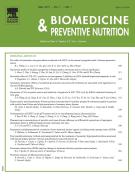Studies on chemical composition of three species of Enteromorpha - 13/08/14
 , K. Suresh Kumar a, 1, P.V. Subba Rao a, Y. Tsukui b, 2, N. Bhaskar b, 2, c, ⁎
, K. Suresh Kumar a, 1, P.V. Subba Rao a, Y. Tsukui b, 2, N. Bhaskar b, 2, c, ⁎  , M. Hosokawa b, 2, K. Miyashita b, 2
, M. Hosokawa b, 2, K. Miyashita b, 2Abstract |
Studies on proximate, mineral, fatty and amino acid composition of edible Enteromorpha species, viz. Enteromorpha compressa, Enteromorpha linza and Enteromorpha tubulosa, collected from the Northwest coast of India, revealed for species-dependent nutrient composition variation. The present study showed a higher amount of sugar (51.05±1.22%), protein (19.09±0.91%) and lipid content (5.56±0.16%) E. tubulosa. Amongst the seventeen elements analyzed (Ca, K, Mg, Na, P, As, Cd, Co, Cu, Fe, Hg, Mn, Mo, Ni, Zn, Cr, Pb), all three species showed a higher amount of calcium content. E. compressa was obtained with rich amount of macro-elements (11.42±0.017g/100g dry wt), while maximum micro- and trace-elements (81.51±6.65mg/100g dry wt) were recorded in E. linza. Amino acid analysis revealed seven out of the 10 essential amino acids were present either in excess or at-par with the reference proteins. Moreover, all the three species studied possessed relatively high n-3 fatty acids; additionally they had more unsaturated fatty acids than saturate ones, except in E. compressa. Therefore, based on the present investigation, it could be stated that the three species studied could be used as food supplements to improve the nutritive value in the omnivorous diet.
Le texte complet de cet article est disponible en PDF.Keywords : Enteromorpha, Seaweed, Proximate, Mineral, Toxic limit, Fatty acids, Amino acids
Plan
Vol 4 - N° 3
P. 365-369 - juillet 2014 Retour au numéroBienvenue sur EM-consulte, la référence des professionnels de santé.
L’accès au texte intégral de cet article nécessite un abonnement.
Déjà abonné à cette revue ?

